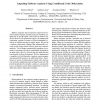NDSS
2008
IEEE
14 years 5 months ago
2008
IEEE
NDSS
2008
IEEE
14 years 5 months ago
2008
IEEE
We study and document an important development in how attackers are using Internet resources: the creation of malicious DNS resolution paths. In this growing form of attack, victi...
NDSS
2008
IEEE
14 years 5 months ago
2008
IEEE
Protocol reverse engineering is the process of extracting application-level specifications for network protocols. Such specifications are very helpful in a number of security-re...
NDSS
2008
IEEE
14 years 5 months ago
2008
IEEE
In [22] we showed that existing single-server computational private information retrieval (PIR) protocols for the purpose of preserving client access patterns leakage are orders o...
NDSS
2008
IEEE
14 years 5 months ago
2008
IEEE
Third Generation (3G) cellular networks utilize timevarying and location-dependent channel conditions to provide broadband services. They employ opportunistic scheduling to effic...
NDSS
2008
IEEE
14 years 5 months ago
2008
IEEE
Malware programs that incorporate trigger-based behavior initiate malicious activities based on conditions satisfied only by specific inputs. State-of-the-art malware analyzers ...
LCN
2008
IEEE
14 years 5 months ago
2008
IEEE
— Although many multicast routing algorithms have been proposed in order to reduce the total cost in WDM optical networks, the link stress and delay are two parameters which are ...
LCN
2008
IEEE
14 years 5 months ago
2008
IEEE
—Carrier Sense Multiple Access (CSMA) protocols in Multi-hop Wireless Networks (MHWN) are known to suffer from different forms of the hidden and exposed terminal problems, leadin...
LCN
2008
IEEE
14 years 5 months ago
2008
IEEE
Location-based services (LBS) are currently receiving world-wide attention as a consequence of the massive usage of mobile devices, but such location services require scalable dis...
LCN
2008
IEEE
14 years 5 months ago
2008
IEEE
—Interest in wireless sensor nodes has escalated over the past 10 years bringing with it a plethora of sensor hardware as well as protocol, algorithmic and application research. ...



